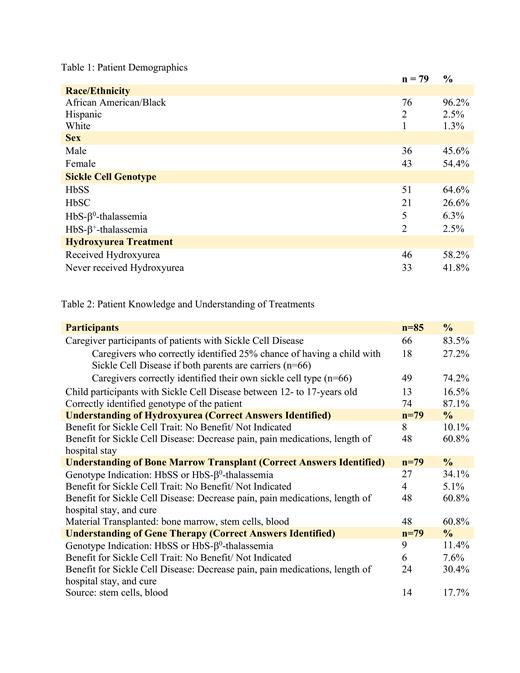Background: Sickle Cell Disease (SCD) affects approximately 100,000 individuals in the United States. Patients require regular follow-up and monitoring to prevent serious complications. Even with rigorous monitoring, health outcomes can be poor due to pain-seeking stigma and other social determinants of health, namely racial, social, and economic disparities. According to the National Assessment of Health Literacy published in 2006, 36% of adults have limited health literacy in the United States. Among SCD populations, disease-specific knowledge can play a vital role in improving pain control and access to appropriate maintenance therapies.
Aims:The purpose of this study is to investigate the knowledge and perceptions of patients with SCD and their caregivers attending The Valerie Fund Pediatric Hematology-Oncology Center at the Children's Hospital of New Jersey in Newark, NJ regarding their disease, complications, genetic impact, general anticipated course of treatment or natural history of disease. Hydroxyurea (HU) and curative therapies include bone marrow transplant (BMT) and gene therapy (GT).
Methods: We surveyed 85 participants, accounting for 79 patients as some surveys were completed by each the patient and caregiver. Sixty-six (83.5%) participants were caregivers and 13 (16.5%) were children with sickle cell disease between 12- and 20-years-old. Most patients identified as black, African, or African American (76; 96.2%) with 2 (2.5%) Hispanic patients, and 1 (1.3%) white patient. Forty-three patients (54.4%) were female and 36 (45.6%) were male. The average age of the patients was 10.9 years with a standard deviation of 5.7 years. More than half of patients were HbSS genotype (51; 64.6%). Remaining genotypes were HbSC (21; 26.6%), HbS-β 0-thalassemia (5; 6.3%), and HbS-β +-thalassemia (2; 2.5%). Forty-six (58.2%) of patients had received HU and 33 (41.8%) had not.
Results: When assessing background knowledge of sickle cell and heritable risk, most participants could correctly identify the patient's sickle cell genotype (74; 87.1%) and most caregivers could correctly identify their own genotype (49; 74.2%). However, many caregivers exhibited limited understanding of genetic risk with only 18 (27.2%) correctly identifying the one in four chance of having a subsequent child with SCD when both parents are carriers.
The results revealed participants could not distinguish between treatment for SCD and sickle cell trait; few participants correctly identified that sickle cell trait is not an indication for treatment with HU (8; 10.1%), BMT (4; 5.1%) or GT (6; 7.6%). Baseline knowledge about BMT and GT was limited. Only 27 (34.1%) participants correctly identified that BMT is indicated for treating patients with HbSS or HbS-b 0-thalassemia, and only 9 (11.4%) participants correctly identified this treatment population for GT. BMT knowledge was slightly greater than GT knowledge, namely that 60.1% (48) correctly identified the benefits of BMT for SCD patients, including decreased pain, decreased need for pain medication, decreased length of hospital stay, and cure, and that either bone marrow, stem cells, or blood could be transplanted materials. Most patients did not correctly identify these benefits of GT (55; 70%), nor could they identify the source of blood or stem cells for GT (65; 82.3%).
The ability to correctly identify the benefits of HU for sickle cell disease (48; 60.8%) was positively associated with the ability to correctly identify the benefits of BMT (p-value 0.0091) and GT (p-value 0.0438) using Fisher's exact test with 95% confidence interval.
Conclusion: These results suggest that dedicated teaching about HU, a common treatment for SCD, can result in greater patient knowledge about newer and curative treatment options of bone marrow transplant and gene therapy. These findings underscore the necessity of implementation of comprehensive patient teaching that is inclusive of population education levels, literacy rates, health literacy rates, and other cultural and societal factors.
Disclosures
No relevant conflicts of interest to declare.


